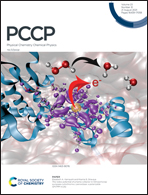Protonation states at different pH, conformational changes and impact of glycosylation in synapsin Ia†
Abstract
Synapsin I (SynI) is the most abundant brain phosphoprotein present at presynaptic terminals that regulates neurotransmitter release, clustering of synaptic vesicles (SVs) at active zones, and stimulates synaptogenesis and neurite outgrowth. Earlier studies have established that SynI displays pH-dependent tethering of SVs to actin filaments and exhibits a maximum binding around neutral pH, however, the effect of pH shift from acidic to basic on the conformational stability of SynI has not been explored yet. Another important aspect of SynIa is its O-GlcNAcylation (O-GlcNac) at the Thr87 position, which is responsible for the positive regulation of synaptic plasticity linked to learning and memory in mice. Furthermore, reduced levels of O-GlcNAc have been observed in Alzheimer's disease, suggesting a possible link to deficits in synaptic plasticity. In this study, the effect of pH and glycosylation on the structure and functional stability of SynIa is determined through molecular dynamics (MD) simulation approach. The 3D structure of SynIa was established via threading-based homology modeling methods. It was observed that the structure of SynIa adopts extended conformational changes as the pH shifts from acidic to basic, resulting in a compact conformation at pH 8.0. Moreover, the results obtained by comparing the glycosylated and unglycosylated protein indicated that the glycan moiety imparts stability to the protein by forming intramolecular hydrogen bond interactions with the protein residues. The results indicate that although O-GlcNAc moieties do not induce a significant change in SynIa structure they minimize protein dynamics, likely leading to enhanced protein stability.



 Please wait while we load your content...
Please wait while we load your content...